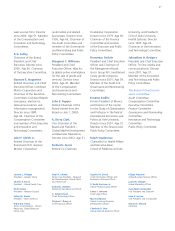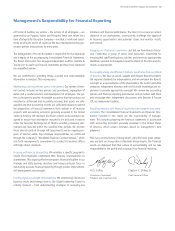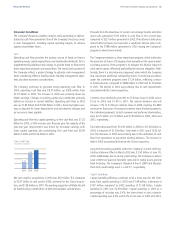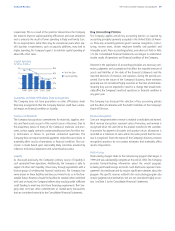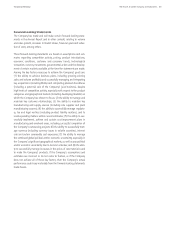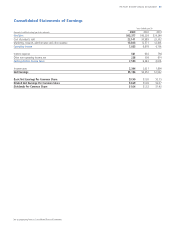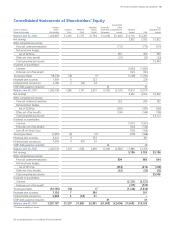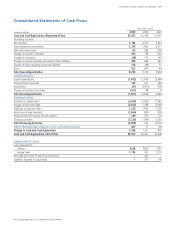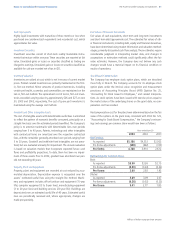Proctor and Gamble 2003 Annual Report Download - page 33
Download and view the complete annual report
Please find page 33 of the 2003 Proctor and Gamble annual report below. You can navigate through the pages in the report by either clicking on the pages listed below, or by using the keyword search tool below to find specific information within the annual report.Financial Review 31The Procter & Gamble Company and Subsidiaries
Currency Rate Exposure
The Company manufactures and sells products in a number of countries
throughout the world and, as a result, is exposed to the impact on rev-
enue and expenses of movements in currency exchange rates. The pri-
mary purpose of the Company’s currency hedging activities is to
reduce the risk that the Company’s financial position will be adversely
affected by short-term changes in exchange rates. Corporate policy pre-
scribes the range of allowable hedging activity. The Company primarily
uses forward exchange contracts and purchased options with maturities
of less than 18 months.
In addition, the Company enters into certain currency swaps with
maturities of up to five years to hedge intercompany financing transac-
tions. The Company also uses purchased currency options with maturi-
ties of generally less than 18 months and forward exchange contracts
to hedge against the effect of exchange rate fluctuations on intercom-
pany royalties and to offset a portion of the effect of exchange rate
fluctuations on income from international operations.
Based on the Company’s overall currency rate exposure as of and dur-
ing the year ended June 30, 2003, including derivative and other instru-
ments sensitive to currency movements, the Company does not believe
a near-term change in currency rates, at a 95% confidence level based
on historical currency rate movements, would materially affect the
Company’s financial statements.
Commodity Price Exposure
Raw materials used by the Company are subject to price volatility
caused by weather, supply conditions, political and economic variables
and other unpredictable factors. The Company uses futures, options and
swap contracts to manage the volatility related to the above exposures.
Commodity hedging activity is not considered material to the Compa-
ny’s financial statements.
Restructuring Program
In 1999, concurrent with a reorganization of its operations into prod-
uct-based global business units, the Company initiated a multi-year re-
structuring program. The program was designed to accelerate growth
and deliver cost reductions by streamlining management decision-mak-
ing, manufacturing and other work processes and discontinuing under-
performing businesses and initiatives. Charges for the program are re-
flected in Corporate because they are corporate-driven decisions and
are not reflected in the operating results used internally to measure and
evaluate the operating segments.
Hedging and Derivative Financial Instruments
As a multinational company with diverse product offerings, the Compa-
ny is exposed to market risks, such as changes in interest rates, currency
exchange rates and commodity prices. To manage the volatility relating
to these exposures, the Company evaluates its exposures on a global
basis to take advantage of the netting opportunities that exist. For the
remaining exposures, the Company enters into various derivative trans-
actions in accordance with the Company’s hedging policies. The finan-
cial impacts of these hedging instruments are offset in part or in whole
by corresponding changes in the underlying exposures being hedged.
The Company does not hold or issue derivative financial instruments for
speculative trading purposes. Note 7 to the Consolidated Financial
Statements includes a detailed discussion of the Company’s accounting
policies for financial instruments.
Derivative positions are monitored using techniques including market
valuation, sensitivity analysis and value-at-risk modeling. The tests for
interest rate and currency rate exposures discussed below are based on
a Monte Carlo simulation value-at-risk model using a one year horizon
and a 95% confidence level. The model incorporates the impact of cor-
relation and diversification from holding multiple currency and interest
rate instruments and assumes that financial returns are normally distrib-
uted. Estimates of volatility and correlations of market factors are drawn
from the RiskMetrics(TM) dataset as of June 30, 2003. In cases where
data is unavailable in RiskMetrics(TM), a reasonable proxy is included.
The Company’s market risk exposures relative to interest and currency
rates, as discussed below, have not changed materially versus the pre-
vious reporting period. In addition, the Company is not aware of any
facts or circumstances that would significantly impact such exposures in
the near term.
Interest Rate Exposure
Interest rate swaps are used to hedge underlying debt obligations. Cer-
tain currency interest rate swaps are designated as hedges of the Com-
pany’s foreign net investments.
Based on the Company’s overall interest rate exposure as of and during
the year ended June 30, 2003, including derivative and other instru-
ments sensitive to interest rates, the Company does not believe a near-
term change in interest rates, at a 95% confidence level based on his-
torical interest rate movements, would materially affect the Company’s
financial statements.


